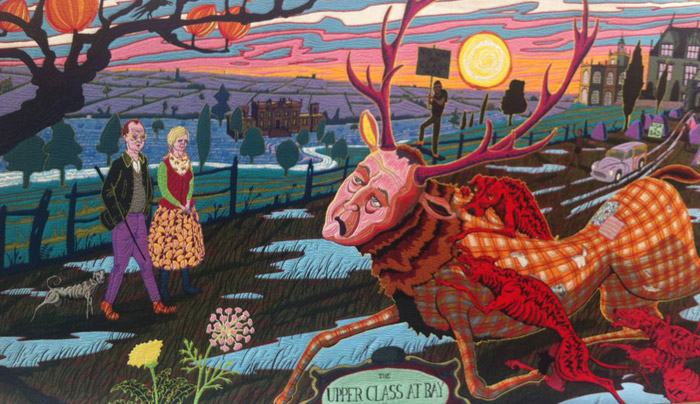
| HOME |
| NERVE |
| REVIEWS |
| ARCHIVE |
| EVENTS |
| LINKS |
| ABOUT US |
| CONTRIBUTORS |
| BACK ISSUES |
| CONTACT US |
 |
The Vanity of Small Differences
Grayson Perry
Walker
Art Gallery
17th May - 10th August 2014
Reviewed by Adam Ford
This summer, Liverpool's Walker Art Gallery is hosting Grayson Perry's 'The Vanity of Small Differences' - a series of tapestries based on a Channel 4 documentary series, where the artist studied the 'taste tribes' of Britain. But it goes far beyond a look at who has iPads and who has country estates. Consciously or not, every scene is a snapshot of a 'United Kingdom' riven by division and barely concealed conflict.
In the television programme 'All in the Best Possible Taste', Perry examined the relationship between the social class that people find themselves a part of, and what they consume. While this had some sociological interest, it nevertheless played into the post-Cold War idea that class conflict is dead, even at a time when the coalition government was setting to work at devastating the poor and further gilding the wealth of the rich.
Though Perry drew on those sessions for his inspiration for this computer-designed and weaved collection, it took him far beyond the TV version's limited scope. Rather than see these 'tribes' as unrelated, each tapestry shows exactly how they are formed, and how they are forcibly separated. Perry achieves this by telling the story of Tim Rakewell as he journeys from life in post-industrial Sunderland to a multi-millionaire's retreat in the countryside, via a successful career in digital technology. But the dream dies in a spectacular car crash, as onlookers tweet about the demise of a their hero (online reaction to the death of Steve Jobs comes to mind).
All the tapestries are fantastic, but it is perhaps 'The Upper Class At Bay' (above) which makes the most profound impact. Using a hunting metaphor, Perry shows that 21st century entrepreneurs have become the new aristocracy, replacing the big landowners and even the old industrial capitalists in their estates. But at the edges, so far unnoticed by the rich, a protest is gathering, as the Occupy movement makes an appearance. One placard urges Tim to pay his taxes, while another proclaims 'No war but class war'. It is significant that the only social mobility Perry can envision in today's Britain must come so blatantly at the expense of others.
There is something very enjoyable about seeing such modern scenes in tapestry form, when tapestry is normally seen as something so dusty and old. There's an urgency in the tale of Tim (and all the people he leaves behind), which almost seems to burst out from the stitching. The immediacy of the social crisis depicted is combined with the instantaneous nature of the technology on show within the images, and indeed the technology used to make them (the weaving of each piece only took a few hours). This all seems so out of place amidst the Victorian architecture of the Walker, but that only serves to make it all the more compelling. As I was leaving, it struck me how rare it is to see people of different social classes in the same artwork, and the contrasts of modernity and antiquity only add to this effect.
Grayson himself has his own internal class conflicts. He came from a poor background, has slammed the coalition's cuts, and talks of the influence that socialist artists had on him, but in January he curtseyed before Prince Charles when collecting a CBE. It's difficult to reconcile social criticism with apparent acceptance of royalty, but somehow he does it. As the protesting figures move closer to the centre of the picture, the time is coming when Perry will have to make a choice.